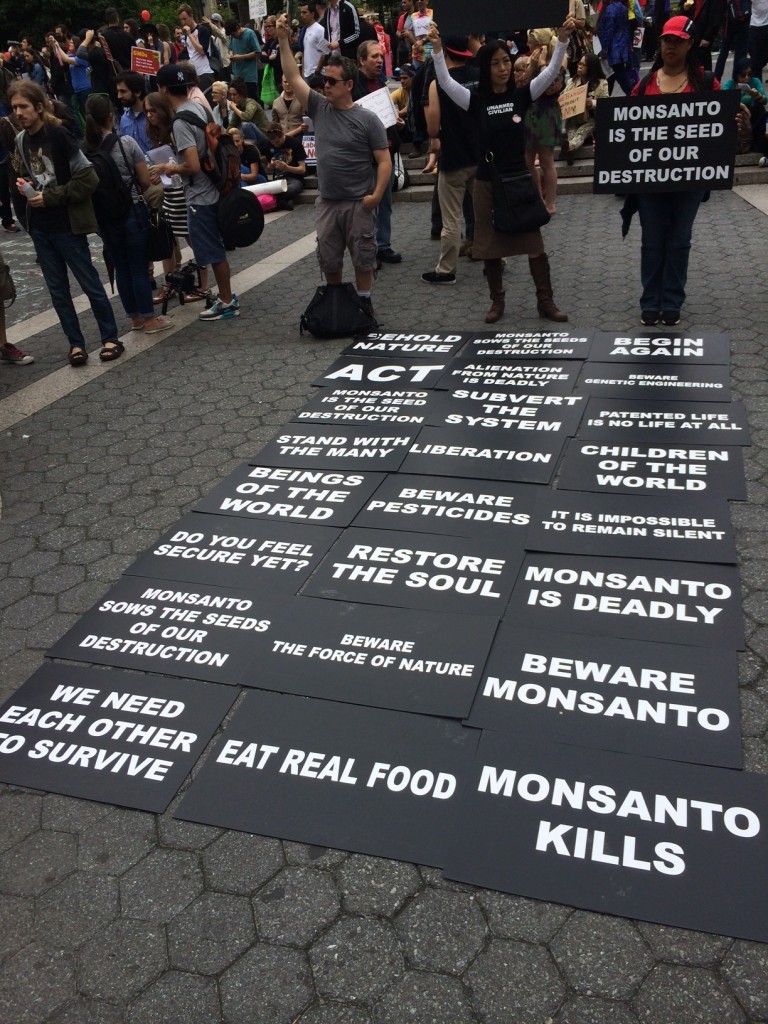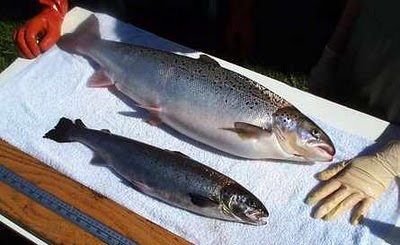GMO: Genetically Modified Olympians
by Keare Smith
“Hell NO GMO! Hell NO GMO!” These were the chants we heard as we randomly stumbled upon an organized group of protestors while walking through the streets of Manhattan. My mother and sister had flown in for a weekend visit, and what better way to get to know the interesting people of New York than to witness a protest? On this particular day a couple weeks ago, a large mass of protestors had gathered in NYC’s Union Square to protest GMO’s and the face of corporate evil, Monsanto.
[am4show not_have=”g5;”]
[/am4show][am4guest]
[/am4guest][am4show have=”g5;”]
Monsanto is the inventor of Roundup, a glyphosphate-based weed killer. The company began receiving bad press for its invention of a special seed that was known as “the terminator” seed. These seeds could only be planted and propagated one time. This new seed could not be replanted the following season, forcing farmers to purchase new seeds every growing season. Although the seeds were never commercially introduced, it was enough to make Monsanto an enemy of many farmers and agricultural activists.
People are drawn to the city of New York for various reasons, one of those being that there is a good chance of encountering another individual in the city who is just like you. Whether you’re a fascist, a vegan, or you have some other belief, with a population of over one million people, you are sure to find another human being who shares your interests and ideologies.
***
What Exactly is a GMO?
The acronym is short for Genetically Modified Organism. Genetic modification involves removing genetic material from the normal physiological make-up of a cell or virus and introducing it into another organism, creating unnatural hybrid traits. With the introduction of this new virus or cell, new genetic material can be added, but it also has the potential to delete existing genetic material. And the alarming part is that a GMO is made through the use of genetic material from any source, whether or not the source is of the same species. That means a scientist can take DNA from a beautiful butterfly and add it to a strain of corn for human consumption.
As illustrated in the photo above, salmon have been genetically modified to grow bigger and faster than real salmon. Genetically modified plants to date have been used mainly to engineer new proteins for herbicide tolerance and insect resistance. Herbicide-tolerant plants are designed to produce one or more proteins that allow the crop to survive being sprayed with a specific herbicide. Insect-resistant plants produce one or more proteins that are harmful to certain species of insects.
In 40 countries, including all European Union nations, China, and Japan, there are significant restrictions or flat-out bans on the production of GMO’s. At the moment, GMO’s have not been proven to be safe. And while there have been countless studies done on GMO’s, no one truly knows their long term effects on our health and the environment. There is a good reason for the sudden rise of food producers labeling their products “GMO free.” Genetic modification is harmful in the eyes of many, and in my opinion it is very unnatural. Nevertheless, today, GMO ingredients are included in 80% of packaged foods in the US. Also, 86% of corn, 90% of canola, 93% of soy, and 93% of cotton produced in the US is genetically modified.
A recent French study has shown that a diet made of genetically modified corn caused series health challenges in their test subjects, rodents. (http://www.english.rfi.fr/americas/20120920-monsanto-gm-maize-may-face-europe-ban-after-french-study-links-cancer)
The rodents, who were fed the GMO corn for two years, developed tumors the size of ping pong balls, suffered from liver damage, and struggled with digestive problems. With such examples, it’s hard not to open your eyes to the true dangers and harmful effects of our genetically modified “frankenfoods.” Next time you place that hot pocket in the microwave think to yourself, is it worth it?
***
So What Does This Have To Do with Athletes?
It’s no secret that modern athletics is tainted by athletes’ desire to gain an edge over their competitors, even if that means taking performance-enhancing drugs. Many athletes are willing to go the extra mile and do whatever it takes to win medals and championships. Lance Armstrong won seven consecutive Tour de France’s between 1999 and 2005. In 2012, Armstrong’s bubble burst as allegations of years of steroid use came to light. It turned out the allegations were true. After confessing, he was stripped of all of his titles, his sponsors dropped him, and he relinquished his role as head of the Lance Armstrong Foundation – the charity organization he had founded to support cancer research. But the most chilling part of the Lance Armstrong story was the fact that he stated that everyone in his sport was using performance-enhancing drugs, and that he wouldn’t have been able to win all of those cycling races without the drugs.
I wonder if he ever thought he’d get caught. It’s hard to imagine that an athlete of Armstrong’s caliber was convinced that what he was doing was moral and justifiable. While researching for this article I learned that the International Olympic Committee is able to keep urine and blood samples for eight years after the Olympic Games. This practice gives science time to catch up to the perpetuators and take action against them many years down the line. But there is a new form of doping that some fear the IOC will never be able to catch: genetic modification of athletes. Over the last few decades athletes have grown bigger, faster, and stronger. This is likely due to advances in training, nutrition, and medical advances. With advances in genetic modifications, the athlete of the future could possibly be a genetically modified super human.
There have been several successful performance-enhancing gene modifications tested on rodents. These tests include genetically generating the growth of explosive fast twitch muscle fibers and artificially stimulating the release of growth hormone releasing hormone (GHRH), which can make the recipient stronger and leaner.
At the recent 2012 Olympic Games in London, China’s 16-year-old swimming sensation Ye Shiwen broke the world record in the 400m event and set a new Olympic record in the 200m event, winning two gold medals. With the stakes high and the athletes at peak condition, breaking world records is common at the Olympic Games. But Shiwen’s records caused some commotion in the swimming world. Just a year prior to the Games, she was relatively unknown in the sport and her times were nowhere close to being on a world record level. Some called her world-record-breaking performance “impossible” and “unbelievable.” http://articles.latimes.com/2012/jul/31/sports/la-sp-on-ye-shiwen-doping-20120731
Ye Shiwen tested negative for any doping agents, but it’s possible that she was the product of the new frontier of doping – genetic modification. Because of the method of genetic enhancement, there is currently no way to know if an athlete is in fact a genetically modified athlete. Similar to the method used to genetically enhance crops, a genetically modified athlete is simply injected with a virus carrying the wanted strands of modified DNA. The virus works by forcing its own DNA into the human cells, which then replicate the DNA, containing biological instructions. This makes it possible for athletes to begin to produce more oxygen-carrying red blood cells or to increase their levels of muscle-building hormones. This basically makes the changes impossible to detect and can bring an athlete a jackpot of medals and championships while the world assumes that his or her superior natural genetics brought the victory.
***
Is All of This Worth It?
In the end, I say no. Seeds, plants, and humans are part of the natural world. When science begins to play “God” and tamper with that which is natural, that’s where I draw the line. Winning gold medals and championships is great, but how far is too far? Eating tasty modern-day food is great, but how much is too much? If athletes and regular individuals realize that simplicity is more valuable than success, we wouldn’t even consider genetically modifying anything. But we humans learn through trial and error. And by the looks of it, based on the protest I saw in New York and on the fact that GMO’s are so restricted in other countries, a lot more people are realizing that sometimes simpler is better.
[/am4show]



